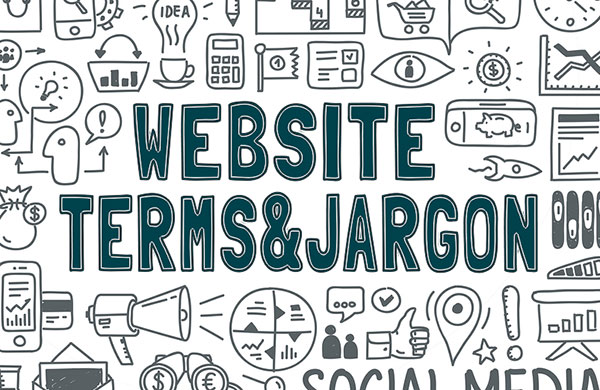Coaching Website Terms to Know
Industry jargon, techie terms, and marketing speak are designed to confuse the bleep out of you. Did we get out?
Just kidding. These phrases are good to know because they relate to strategies for helping you grow your coaching business.
Below are popular terms used websites, online marketing, and selling and my way of thinking about them, especially when it comes to websites for coaches.
Blog
Web + Log = Weblog (or simply Blog)
A blog is simply a website for logging content (kinda like a diary). web + log = weblog or simply blog.
In the early days, blogs were used to track weight loss, a personal trip or share favorite recipes.
Today, businesses use them to build credibility. For coaches, it’s a great vehicle to build a big following and attract new clients.
Strategically, use your blog to build your expert image by posting articles that showcase your knowledge. Share blogs in your client hangouts to bring traffic. Make it fun by playing to your strengths – use video if you like speaking, or use humor if you’re funny. I like using stick figure drawings to teach concepts.
Client-Attraction Design
Attraction Design, Attraction Web Design
Client-attraction design is combining words, visuals, and interactivity on a website to attract ideal clients and encourage them to contact you (about coaching).
Such a website has:
- Features that bring visitors to it like a free giveaway, great articles, and smart keywords
- Content that builds credibility and wins trust so people see you as a talented coach
- Calls-to-action that invite visitors to take steps towards contacting you and becoming your client
The “expert website”, which I talk about in The Coaching Website Guide, is one application of attraction design.
* The key to attraction design is thinking about things from your client’s perspective. You’ll want all of your website elements to engage, educate, inspire and excite them.
Client Hangouts
Target Rich Environments, Client Sources
These are places where your ideal clients gather in some way shape or form.
It’s a place for getting in front of potential clients.
For example, one of my clients published an article in a trade magazine for builders. It took some time to find this hangout and start getting traffic from it. We had to …
- research places online
- contact the publisher
- submit a request
- write an article
- get approved
- setup a link to our website
But after it was all done, traffic went up, new subscribers were added and new clients came.
Strategically, take the time to find places where your ideal clients spend time interacting or consuming information. These can be both online like social media sites, discussion groups, blogs OR offline like meet-up groups, networking events, or magazines.
Learn how to create a simple but powerful website that brings you new clients in The Coaching Website Guide.
Compelling Core Message
Your core message is the short 1-2 sentence write-up that tells what you do in a compelling way.
It’s like an elevator speech or your 30-second intro often used in networking groups except this is for your website.
Many coaches don’t have a core message and their websites end up boring, weak or confusing (or all three).
Here are two articles about creating a compelling core message:
- How to Ensure Your Site is Compelling + Watch Two Clients Develop Their Core Message
- How to Get More Leads with Your Core Message
The key to a compelling core message is to make sure it’s written from the client’s perspective.
 Call-to-Action
Call-to-Action
This is an invitation for your visitors to complete a task on your website. Some examples include:
- click on a link
- fill out a form
- buy an ebook
- register for a webinar
- sign up for your email list
- contact you by email or phone
- leave a comment on your blog
- like a page
- watch a video
* The key is to give people very compelling reasons for taking action. For example, you can give a free pdf checklist (reason #1) as a gift if they sign up for your email list that promises insider secrets to success (reason #2).
Domain Name
When people ask, What’s your website? or What’s your address?, or What’s your URL? they want to know your domain name.
URL, which is a bit more technical, stands for uniform (or universal) resource locator.
For example, the domain name of this website is www.coachingsitesthatwork.com.
Your domain name is simply the pointer to a location on the Web (a computer) where your website exists (all the files, images, etc).
Every website must have a domain name, though you don’t always have to pay for one.
The free ones aren’t great for branding and hint that the website and business behind it is amateur. For example, www.weebly.com/johnswebsite.
You need to register your domain name to own it and manage it. It doesn’t cost much, about $10 a year. I like Bluehost for both registering your domain name and getting hosting. You can also use Godaddy if you start accumulating more domain names.
Strategically, for you to get a domain name that’s good for client-attraction, make it simple to spell, easy to remember, and related to what you do, and if possible, point out benefits.
Here are two articles to help:
- How to Find the Perfect and Available Domain Name and Quickly Setup WordPress
- 10 Keys to a Catchy Coaching Domain Name
Email Series
Autoresponders, Email Sequence, E-course
An autoresponder is an automatic response by email. An email series is a bunch of these.
You can schedule them over time to deliver content to those who request it.
You can teach several lessons over a handful of emails, thus making it a course or sequence.
They are great because you can automate the content delivery – thus saving your time.
* Strategically, use these emails to teach, build trust, and engage your email list subscriber so that they see you’re an awesome coach they should call.
Expert Image
Expert Status
People love to work with experts.
And since the title expert has no definition, you only need to look like one to reap the benefits of it.
Nonetheless, conceptually, you want to showcase your smarts and intelligence and build an image that attracts people. An expert image.
* Strategically, do things that experts would do like post articles, write books, share success stories, have a professional photo, show education, give talks, highlight media appearances, and make videos.
The Expert Website
This is a special kind of website to build your credibility so that visitors see you as a true pro, an expert at what you do, and will, as a result, want to work with you.
People (especially those who likely to pay high fees for one-on-one attention) are drawn to experts. And so, being an expert is great for attracting clients.
However, the designation of “an expert” isn’t attainable by some specific criteria or governing body. Rather it’s attained by creating the image of an expert.
Sadly, an otherwise truly talented, highly-skilled coach with a website that looks novice will fair worse, given all things equal, than a not-so-good whose website exhibits indicators of an expert.
A website that shows you’re an expert would include things like educational articles, an active blog, accomplishments, stories from clients, and testimonials from other gurus.
I go into a ton of detail about this in The Coaching Website Guide and how you can attract the best clients (can pay high fees, are good for 1on1 relationships, will work hard to get results).
* The key to creating an expert website is stick to the kind of content that a visitor would deem an expert to have. Build the image.
Hosting
Aka Web Hosting
This is a service that keeps a server (simply a computer) running so that that your website (files, database, images, everything) is fully functional and running smoothly 24/7.
Check out Bluehost for hosting (register your domain name there too if you haven’t already). They are great for WordPress too.
* Strategically, your hosting service should be a non-issue – just set it up and forget it, unless you get a problem like your site is slow or doesn’t open up properly. Test your website regularly.
Ideal Client
Similar: Avatar, Persona, Dream Client, Niche, Target Market, Audience, Client Profile
These terms are related and all reflect the person or persons you’re aiming to appeal to with your website.
It’s a good move to get clear(er) on who you’d like as your clients before you build your website as it will guide you on creating copy to appeal to them.
There’s no arguing – we (people) love websites that are tailored to our specific needs. And we quickly leave websites that are too general, or unrelated.
That being said, just because you identify an ideal client, doesn’t guarantee success. And on the flip side, just because you don’t have a clear client profile, it doesn’t mean you can’t succeed.
I’ve seen coaches come with their dream client defined, yet fail to get any traction AND I’ve seen coaches without a crystal clear target client fill up their practice.
In the end, success comes with action, learning, trying, and growing for which I can respect.
* I like to spend time identifying an ideal client, quickly getting a website up and see if you can get results with it including things like traffic, followers, list subscribers, and new client leads.
Landing Page
A page where you want people to “land” first. This will depend on where you’re getting visitors from. Thus, this page is very specific to the intention – in most cases to capture an email address.
Here are two examples to help you get it …
1. (Most common use) Say you your goal is to grow your email list and you have no website or blog. You make a 1-page website with a form that people can enter their email address into. You call this page a landing page for your intention of getting people to subscribe. You could call this an opt-in landing page.
2. You create a sales page for your ebook with reasons to buy it, testimonials and a big buy-now button. You also set up Google ads to send people to that page to buy. Thus that sales page is the landing page for your intention of getting ads to sell your ebook.
* Strategically, for a landing page that works (1) stick to one call-to-action (2) keep the task easy to do (3) give people lots of reasons to take action, and (3) avoid distracting content that confuses or slow down visitors.
Lead Magnet
Also called freebie, giveaway, lead magnet
A lead magnet is anything you put out there that attracts a person to your website.
This could be a free video, report, checklist or any other giveaway that entices people to go from where they are to click to your website for the freebie and to jump on your email list to get it.
A search on Google got me this nice definition …
A lead magnet is an irresistible bribe offering a specific chunk of value to a prospect in exchange for their contact information. The goal of the Lead Magnet is to maximize the number of targeted leads you are getting for an offer.

* Strategically, your freebie is often your first lead magnet. You share it in places your ideal clients’ hang out so you can invite them to come to your site and download it and get on your email list where you start developing the relationship.
List
Email List, Database, Opt-ins, Opt-in List, Subscribers
Your list refers to the database of email addresses you’ve accumulated or acquired.
Ideally, those people on your list have chosen to be there (you have their permission to email them) and are interested in what you have to say (are more likely to buy).
* The key to success with your email list is to (1) nurture the relationship with your subscribers by sending helpful information and (2) to send offers to them to buy from you (or take a step towards buying like having a phone call with you about 1on1 coaching) so that your business profits.
Sales Funnel
Similar: marketing funnel, sales funnel, sales pipeline, funnel
This is is a strategic order of steps (pages, emails, videos, offers, and even personal interactions) that sequentially leads potential customers to buy something from you like an ebook, a membership offer, or another program.
It can be simple or complex.
* Strategically, for coaches who are seeking 1-on-1 clients and whose websites are a piece of the process, there will be (1) some initial attention grabber (ad, article, email, other) (2) mechanism (pages, videos, email list, webinar, any) at the website to engage, excite and essentially sell them to (3) get onto a call with the coach to close the deal.
Squeeze Page
Squeeze pages are similar to landing pages in that they are a single page with one action available which is to add their email address to the list.
For example, if a website says you can watch an awesome video and then you click, and then a page shows up that requires you to enter your email address before continuing, then you’ve hit a squeeze page.
The page is “squeezed in” to get your email address before you see the video.
* Strategically, a great squeeze page will ask people to enter their email address to get to gain access to privy content like a training video.
Strategy Session
Sales Call, Free Session, Free Consultation

This coach is conducting a strategy session to secure a paid coaching commitment.
The strategy session is a special kind of coaching session that focuses on the big picture goals for the coachee while positioning you, the coach, as an ideal catalyst for reaching those goals.
This helps you sign up new clients or extend work with existing clients.
Typically, “free consults” are thought of as a sales pitch. While a “strategy session” is less intimidating and can appear more valuable.
* Strategically to make this work, build up the value when you offer your strategy session. Then, when conducting the session, ask questions about the client’s biggest desires.
Visibility Strategies
Marketing Strategies, Outreach, Traffic Building
These are the plans you have to get out in front of potential clients and drive them to your website and into your sales funnel.
For example,
- Publish an article
- Be a guest on a podcast
- Optimize your website for search engines
- Facebook Ads
- Joining networking groups online and offline
Incidentally, giving a talk is not exactly a visibility strategy because your talk will itself need to be advertised or told to people. So giving talks needs its own outreach.
Also, creating a website isn’t a visibility strategy either because the website’s existence doesn’t get you in front of potential clients. A website is a tool for sending people from the visibility strategy.
* The key to setting up great visibility strategies is to (1) find some places with potential clients and (2) establishing a means to get your name across in those places.
[fblike]


 Call-to-Action
Call-to-Action


Stick figure drawings are great. Lots of personality. Makes the concepts come alive too. Squeeze page–perfect title. (makes the annoying interruption while reading tolerable) 😉
Thanks everyone for the positive words.
Great explanations, plus you’ve thrown in some fantastic tips. Thank you.
Excellent article. It is a thorough, and detail roadmap; that works equally well for newbies and veterans.
Good reminders Ken…went through the checklist yet again… I have been live for a week…
Great article! Will print out for future reminder.
Kenn,
This is very helpful. Appreciate your content – it is always extremely practical and useful.
Joe
Thanks Ken,
This was really interesting. The ‘Lead Magnet’ was especially useful.
I think that too many times we try to speak in ‘coaching’ terms rather than using the client’s language. Covering the ‘what’s in it for me’ is also important.
Thanks again for all of the information you share.
Kind regards,
David
Thanks for the positive words David. Happy to support. If you have your lead magnet (freebie or such), or an idea for one, love to hear about it. Just reply with a comment.
Great article! Do you work with people other than coaches? I am a counselor, and am reinventing myself as a career counselor, speaker, writer, and specialist.
I didn’t know where Blog came from…Web + log….so neat…maybe tht will show up in the next trivial pursuit game.
Chose this article at random..love the image..black and white…clarifies this and that.
Overall informative and easy to follow…and of course, educational.
Your expertise is showing.
I like your identity as a website strategist vs. website designer. Looking for the “system” part of your overall work…indeed it’s the strategies within the overall system.
…at least that’s the way my brain is working this am.
…and I got to this article from another main page…so I’m still reading.
Very helpful article and really gave me an true understanding of the importance of how to attract clients and target them for future coaching work. It’s clear and straight to the point and written in a way that gives you confidence to act and not to do a u turn of fear!
Great … thanks for the positive words … any specific questions or other terms that make you go cross-eyed? 🙂